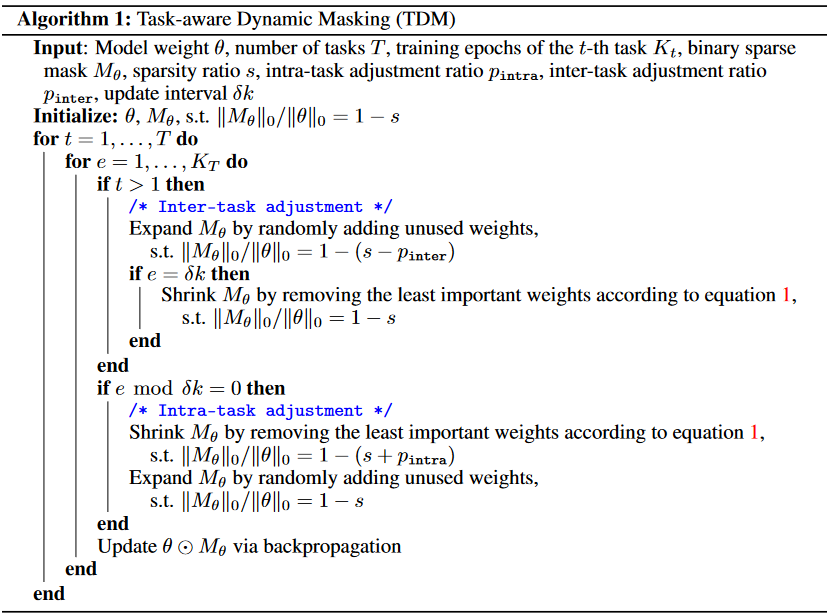Sparse Continual Learning on the Edge
NeurIPS 2022 paper.
TLDR

- Task-aware dynamic mask TDM :
Based on $CWI$, keep only important weights for both current & past tasks.
++ consider task transition - Dynamic Gradient Masking DGM :
Based on $CGI$, select important weights to update,
only a subset of sparse weight updated to leverage gradient sparcity.
Quick Look
- Authors & Affiliation: Zifeng Wang
- Link: https://arxiv.org/pdf/2209.09476.pdf
- Comments: NeurIPS 2022
- Relevance: 4.5
Research Topic
- Category (General): Continual Learning
- Category (Specific): Continual Learning, Lottery Ticket Theorem
Paper Summary (What)
- Use two types of masks, $M_w$ and $M_g$ based on slightly different importance metrics.
- Dynamic Data Removal DDR : remove ‘easy’ examples regarding to loss,
keep more informative examples in the replay buffer. - $CWI$ for $M_w$
\(CWI = \text{L1 norm of }W + \text{gradient w.r.t task data } D_t + \text{gradient w.r.t rehearsal buffer} R\) - $CGI$ for $M_g$
\(CGI = \text{grad w.r.t task data }D_t + \text{gradient w.r.t rehearsal buffer} R\) - Update mask by retaining weights with high $CWI$ or $CGI$ value.
Notable References
Thoughts
Isn’t $CWI$ and $CGI$ are redundant metrics, i.e. not orthogonal enough?
Applying different masks for forward/backward phase is notable.
Somewhat very similar with my idea, but somewhat different from what I thought.
Footnote
아래와 같은 양식을 활용한다.
#
## Quick Look
- **Authors & Affiliation**: [Authors][Affiliations]
- **Link**: [Paper link]
- **Comments**: [e.g. Published at X / arXiv paper / in review.]
- **TLDR**: [One or at most two line summary]
- **Relevance**: [Score between 1 and 5, stating how relevant this paper is to your work. Usually filled in at the end.]
# Research Topic
- **Category** (General):
- **Category** (Specific):
# Paper Summary (What)
[Summary of the paper - a few sentences with bullet points. What did they do?]